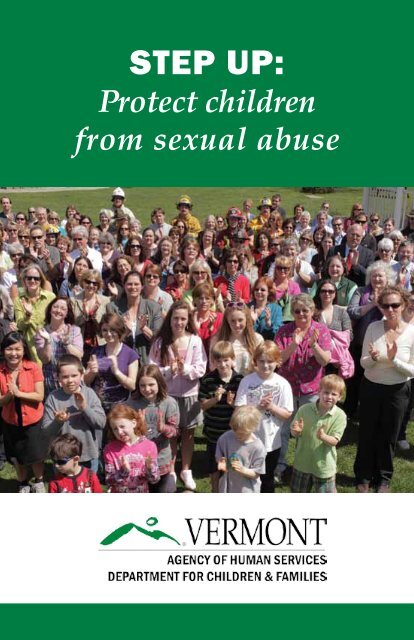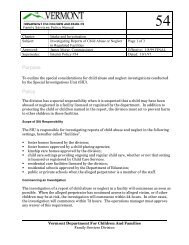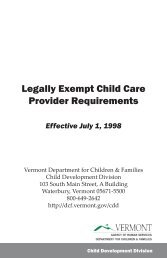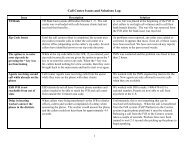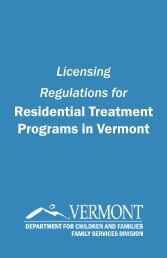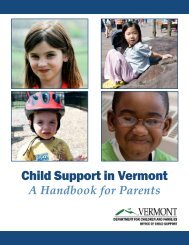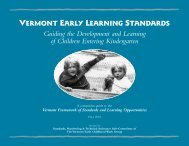STEP UP: Protect Children from Sexual Abuse - Department for ...
STEP UP: Protect Children from Sexual Abuse - Department for ...
STEP UP: Protect Children from Sexual Abuse - Department for ...
Create successful ePaper yourself
Turn your PDF publications into a flip-book with our unique Google optimized e-Paper software.
<strong>STEP</strong> <strong>UP</strong>:<br />
<strong>Protect</strong> children<br />
<strong>from</strong> sexual abuse
© 2010, Vermont <strong>Department</strong> <strong>for</strong> <strong>Children</strong> and Families<br />
In<strong>for</strong>mation in this guide may be reproduced <strong>for</strong> personal,<br />
educational, and non-profit use only. The Vermont <strong>Department</strong><br />
<strong>for</strong> <strong>Children</strong> and Families should be identified as the source of<br />
the materials and any reproduction should not be represented<br />
as an official version of the materials reproduced.
Table of Contents<br />
INTRODUCTION.....................................................................4<br />
SECTION 1: EDUCATE YOURSELF......................................5<br />
What Child <strong>Sexual</strong> <strong>Abuse</strong> Is. ....................................................5<br />
How Often It Happens...............................................................6<br />
Who <strong>Sexual</strong>ly <strong>Abuse</strong>s <strong>Children</strong>................................................7<br />
How <strong>Sexual</strong> <strong>Abuse</strong> Happens.....................................................7<br />
What To Look For.....................................................................10<br />
Why <strong>Children</strong> May Not Tell...................................................13<br />
SECTION 2: PLAN FOR SAFETY.........................................17<br />
Step One: Identify <strong>Protect</strong>ive Factors....................................17<br />
Step Two: Identify Risk Factors..............................................18<br />
Step Three: Develop A Plan ....................................................20<br />
Step Four: Put Your Plan Into Action.....................................21<br />
SECTION 3: TALK ABOUT IT..............................................22<br />
Talk To Your <strong>Children</strong> About Healthy <strong>Sexual</strong>ity..................22<br />
Talk To Your <strong>Children</strong> About Personal Safety......................24<br />
Talk to Other Adults About Child <strong>Sexual</strong> <strong>Abuse</strong>.................26<br />
SECTION 4: TAKE ACTION.................................................27<br />
If You Suspect Child <strong>Sexual</strong> <strong>Abuse</strong>........................................27<br />
If You Notice Inappropriate Behavior....................................27<br />
Situations You Might Encounter.............................................28<br />
SECTION 5: FIND RESOURCES.........................................32<br />
Advocacy Services....................................................................32<br />
Helplines.....................................................................................33<br />
Hotlines.......................................................................................33<br />
Mental Health Services...........................................................33<br />
Referral Services........................................................................33<br />
Websites......................................................................................34<br />
3
INTRODUCTION<br />
Child sexual abuse is a serious problem — most often<br />
committed by people we know and trust. Experts estimate<br />
that one in four girls and one in six boys 1 are sexually<br />
abused be<strong>for</strong>e their 18th birthday. While this in<strong>for</strong>mation is<br />
troubling, it’s important to know that there are steps you can<br />
take as a parent to reduce the risk to your children.<br />
The first, and perhaps most important, step is to take<br />
responsibility <strong>for</strong> protecting your children <strong>from</strong> sexual<br />
abuse. While you can and should teach them about<br />
personal safety and appropriate boundaries, they cannot<br />
be responsible <strong>for</strong> protecting themselves <strong>from</strong> sexual<br />
predators. You are your children’s first line of defense.<br />
You cannot, however, do it alone. You depend on others<br />
(e.g., family members, friends, child care providers, and<br />
teachers) to help keep your children safe. The safety of<br />
our children truly lies in the hands of our community. We<br />
all need to step up to protect children and keep them safe<br />
<strong>from</strong> abuse, no matter what our relationship is to them<br />
(e.g., parent, aunt, uncle, grandparent, family friend, or<br />
teacher).<br />
This guide was produced by the Vermont <strong>Department</strong><br />
<strong>for</strong> <strong>Children</strong> and Families (DCF), in partnership with<br />
community organizations, to help you prevent, identify,<br />
and react responsibly to child sexual abuse.<br />
If these issues raise strong emotions because of your own<br />
history of sexual abuse, please be sure to seek out support<br />
and resources <strong>for</strong> yourself.<br />
1 ACE Study - Prevalence - Adverse Childhood Experiences<br />
(http://www.cdc.gov/nccdphp/ace/prevalence.htm)<br />
4
SECTION 1 - EDUCATE YOURSELF<br />
Child sexual abuse is a serious problem — most often<br />
committed by people we know and trust.<br />
Knowing the facts can help you keep your children safe.<br />
This includes:<br />
• What child sexual abuse is;<br />
• How often it happens;<br />
• Who sexually abuses children;<br />
• How sexual abuse happens;<br />
• What to look <strong>for</strong>; and<br />
• Why children may not tell.<br />
What Child <strong>Sexual</strong> <strong>Abuse</strong> Is<br />
Child sexual abuse can include actual physical contact as<br />
well as behavior that does not include physical contact.<br />
Vermont’s child protection law defines sexual abuse as:<br />
Any act or acts by any person involving sexual<br />
molestation or exploitation of a child including but not<br />
limited to incest, prostitution, rape, sodomy, or any lewd<br />
and lascivious conduct involving a child.<br />
It also includes the aiding, abetting, counseling, hiring,<br />
or procuring of a child to per<strong>for</strong>m or participate in<br />
any photograph, motion picture, exhibition, show,<br />
representation, or other presentation which, in whole or<br />
in part, depicts a sexual conduct, sexual excitement, or<br />
sadomasochistic abuse involving a child.<br />
33 V.S.A. § 4912<br />
5
Contact sexual abuse includes:<br />
• Touching the genital area, over or under clothing;<br />
• Touching breasts, over or under clothing;<br />
• Touching another person’s genital area;<br />
• Oral sex; and<br />
• Vaginal or anal penetration with a part of the body<br />
(e.g., finger, penis) or with an object.<br />
Non-contact sexual abuse includes:<br />
• Invitation to touch another in a sexual way;<br />
• Voyeurism (Peeping Tom);<br />
• Encouraging or <strong>for</strong>cing a child to masturbate or to<br />
watch others masturbate;<br />
• Indecent exposure (flashing) or showing genital<br />
areas;<br />
• Involving children in the viewing or production<br />
of pornographic materials or in watching sexual<br />
activities; and<br />
• Encouraging children to behave in sexual ways<br />
(e.g., simulating intercourse).<br />
How Often It Happens<br />
Child sexual abuse happens to children of all ages — <strong>from</strong><br />
infants to teens. And it happens more often than most<br />
people think.<br />
Experts estimate that one in four girls and one in six boys<br />
are sexually abused be<strong>for</strong>e their 18th birthday.<br />
6
Who <strong>Sexual</strong>ly <strong>Abuse</strong>s <strong>Children</strong><br />
It’s impossible to describe a typical abuser. They look and<br />
act in various ways, can be found in all areas of society,<br />
and are often well-respected members of our communities.<br />
They may appear to be kind, caring people who are great<br />
with kids. <strong>Abuse</strong>rs work hard to cultivate this image—so<br />
people will not suspect them of, and will not believe it if<br />
they are ever accused of, sexually abusing children.<br />
Here’s what research tells us:<br />
1. Nearly all child sexual abuse is committed by people<br />
known to children and families, including:<br />
• Family members such as parents, stepparents,<br />
siblings, grandparents, uncles, and cousins; and<br />
• People in a family’s circle of trust such as friends,<br />
neighbors, teachers, and coaches.<br />
2. Most abusers are male — although females also<br />
sexually abuse children.<br />
3. Over a third of abusers are under the age of 20.<br />
What abusers all have in common is this: they have<br />
thought about being sexual with children and have acted<br />
on those thoughts.<br />
How <strong>Sexual</strong> <strong>Abuse</strong> Happens<br />
An abuser needs two things to sexually abuse a child:<br />
1. Access to a child; and<br />
2. Time alone with the child.<br />
Although they use a variety of techniques, abusers most<br />
often use a process known as grooming to gain control of,<br />
and access to, children.<br />
7
How <strong>Abuse</strong>rs “Groom” <strong>Children</strong><br />
Grooming is a subtle, gradual, and escalating process<br />
of building trust with a child. It is deliberate and<br />
purposeful. <strong>Abuse</strong>rs may groom children <strong>for</strong> weeks,<br />
months, or even years—be<strong>for</strong>e any sexual abuse<br />
actually takes place. It usually begins with behaviors<br />
that may not even seem to be inappropriate.<br />
Grooming children may include:<br />
• Befriending a child and gaining his or her trust.<br />
• Testing a child’s boundaries through telling<br />
inappropriate jokes, roughhousing, backrubs,<br />
tickling, or sexual games.<br />
• Moving <strong>from</strong> non-sexual touching to “accidental”<br />
sexual touching. This typically happens during<br />
play so the child may not even identify it as<br />
purposeful, inappropriate touching. It is often<br />
done slowly so the child is gradually desensitized<br />
to the touch.<br />
• Manipulating the child to not tell anyone about<br />
what is happening. The abuser may use a child’s<br />
fear, embarrassment, or guilt about what has<br />
happened. Sometimes, the abuser uses bribery,<br />
threats, or coercion.<br />
• Confusing the child into feeling responsible<br />
<strong>for</strong> the abuse. <strong>Children</strong> may not notice or<br />
may become confused as the contact becomes<br />
increasingly intimate and sexual.<br />
8
How <strong>Abuse</strong>rs “Groom” Adolescents<br />
Grooming adolescents may include additional<br />
strategies, such as:<br />
• Identifying with the adolescent. The abuser may<br />
appear to be the only one who understands him/<br />
her.<br />
• Displaying common interests in sports, music,<br />
movies, video games, television shows, etc.<br />
• Recognizing and filling the adolescent’s need <strong>for</strong><br />
affection and attention.<br />
• Giving gifts or special privileges to the adolescent.<br />
• Allowing or encouraging the adolescent to break<br />
rules (e.g., smoking, drinking, using drugs,<br />
viewing pornography).<br />
• Communicating with the adolescent outside of<br />
the person’s role (e.g., teacher, or coach). This<br />
could include, <strong>for</strong> example, texting or emailing<br />
the teen without the parents’ knowledge.<br />
How <strong>Abuse</strong>rs “Groom” Adults<br />
It is not just children and adolescents who are<br />
groomed. <strong>Abuse</strong>rs also work hard to gain the trust of<br />
the adults around a child/youth (e.g., parents, other<br />
family members, and coworkers). This may include:<br />
• Befriending the parents or other caregivers.<br />
• Looking <strong>for</strong> opportunities to have time alone with<br />
a child (e.g., offering to babysit or inviting the<br />
child <strong>for</strong> a sleepover).<br />
9
What To Look For<br />
It’s important <strong>for</strong> your children’s growth and development<br />
to have supportive relationships with adults other than<br />
you. At the same time, you need to be mindful of who is<br />
spending time with your children since most child sexual<br />
abuse is committed by people families know and trust.<br />
You may be thinking “How do I know who to trust?” There<br />
is no easy answer. But it might help to pay attention to a<br />
person’s behavior rather than what you think about the<br />
person’s character (e.g., she’s so nice) or your relationship to<br />
the person (e.g., he’s family, he’d never hurt our child).<br />
Pay particular attention when an adult or older youth:<br />
• Seems overly interested in, and creates opportunities to<br />
be alone with, your child.<br />
• Displays favoritism towards one child in your family or<br />
a group of children.<br />
• Gives special privileges or gifts to your child (e.g.,<br />
money, trips, special favors).<br />
• Befriends your family and shows more interest in a<br />
relationship with your child than with you.<br />
• Plays with your child in a way that makes you<br />
uncom<strong>for</strong>table.<br />
• Seems “too good to be true” (e.g., babysitting <strong>for</strong> free,<br />
taking your child on special outings alone).<br />
• Minimizes any concerns you raise about how he/she is<br />
interacting with your child.<br />
• Creates opportunities to be around your child outside<br />
the context of their role as teacher, coach, etc.<br />
While these behaviors do not necessarily indicate a person<br />
is grooming your child or family, they could be considered<br />
inappropriate.<br />
10
Concerning Adult/Youth Behavior<br />
Watch <strong>for</strong> any of the following behaviors:<br />
• Deliberately walking in on your child changing or<br />
using the bathroom.<br />
• Asking or having your child watch the adult/youth<br />
change or use the bathroom.<br />
• Tickling and accidentally touching genitalia.<br />
• Activities that involve removing clothes (e.g.,<br />
getting massages, swimming).<br />
• Wrestling or roughhousing.<br />
• Telling your child sexually-explicit jokes.<br />
• Teasing your child about breast or genital<br />
development.<br />
• Discussing sexually-explicit in<strong>for</strong>mation with your<br />
child or showing your child sexually-explicit images<br />
or pornography.<br />
• Bathing or showering with your child.<br />
• Looking at or taking pictures of your child in his/her<br />
underwear or bathing suit.<br />
• Making sexual comments or sharing inappropriate<br />
stories about sexual activity.<br />
When reflecting on someone’s behavior, consider:<br />
• Does it seem weird?<br />
• Does it make you feel uncom<strong>for</strong>table?<br />
• Does it seem to happen all the time or too often?<br />
• Has anyone else commented or noticed?<br />
(See Section 4 - Take Action <strong>for</strong> in<strong>for</strong>mation on how you<br />
might respond to inappropriate behavior.)<br />
11
Concerns About Your <strong>Children</strong>’s Behavior<br />
It is challenging enough to think about protecting your<br />
children <strong>from</strong> sexual abusers. It may be even more<br />
challenging to consider that your children may behave in<br />
sexually inappropriate ways that could victimize others.<br />
It is not always easy to tell the difference between natural<br />
sexual curiosity and potentially abusive behaviors. It is<br />
essential, however, to pay attention to your children’s actions<br />
and know where to turn to <strong>for</strong> help if they exhibit any<br />
behaviors listed on previous pages.<br />
You may worry that you’re overreacting and may be<br />
concerned about the possible consequences of taking<br />
action. Remember, evidence shows that the earlier children<br />
and youth get help, the more they are able to learn the<br />
skills they need to control their behaviors. It is much better<br />
to address a situation early than to later discover you were<br />
right to be concerned and did nothing.<br />
Help is available. The resource listed below has helpful<br />
in<strong>for</strong>mation about “normal” sexual behaviors in children<br />
(by age group). It will also help you approach this difficult<br />
issue if the need arises.<br />
Helpful Resource<br />
Do <strong>Children</strong> <strong>Sexual</strong>ly <strong>Abuse</strong> Other <strong>Children</strong>?<br />
Preventing <strong>Sexual</strong> <strong>Abuse</strong> Among <strong>Children</strong> and Youth<br />
Published by:<br />
Stop It Now!®.<br />
351 Pleasant Street, Suite B-319<br />
Northampton, MA 01060, USA,<br />
(413) 587-3500, www.stopitnow.org/guidebooks<br />
12
Why <strong>Children</strong> May Not Tell<br />
Research indicates that most victims of child sexual abuse<br />
never tell (or disclose) about abuse during childhood. A<br />
child’s decision whether to tell does not rest solely with<br />
the child, it also depends on the behavior of the protective<br />
adults in a child’s life.<br />
There are many reasons children may delay telling or never<br />
tell. They might, <strong>for</strong> example:<br />
• Be afraid of not being believed or of being judged.<br />
• Be ashamed, embarrassed about, or feel responsible <strong>for</strong><br />
the abuse.<br />
• Have been threatened by the abuser—with violence<br />
against themselves, their family, friends, or pets.<br />
• Not want to lose any perceived benefits (e.g., gifts,<br />
affection, love, acceptance, or status).<br />
• Not know who they can tell.<br />
• Be afraid of what will happen if they tell (e.g., the<br />
family will break up, a parent will go to jail).<br />
• Not recognize they have been abused. This is especially<br />
true <strong>for</strong> young children and those with disabilities.<br />
You can increase the likelihood your children would tell by:<br />
• Having open and honest communication with them—<br />
about healthy sexual development and personal safety.<br />
• Making sure they have the words they need to<br />
describe situations that make them feel mixed up or<br />
uncom<strong>for</strong>table.<br />
• Letting them know children are never responsible <strong>for</strong><br />
abuse.<br />
It’s important to understand that even with your best<br />
ef<strong>for</strong>ts, your child may still not be able to tell.<br />
13
How to Recognize <strong>Children</strong>’s Disclosure<br />
It is not always obvious when children disclose about<br />
sexual abuse and can be easy to miss. <strong>Children</strong> are usually<br />
not this clear and direct: I was sexually abused. It might<br />
sound more like: I don’t want to go to Uncle Joe’s house<br />
anymore or Please don’t leave me alone with her.<br />
<strong>Children</strong> might disclose all at once but are more likely to<br />
give a little in<strong>for</strong>mation at a time. This could happen over<br />
several hours, weeks, months, or even years as the children<br />
test the reactions to their words.<br />
During disclosure, children might seem hesitant, confused,<br />
or uncertain. Afterwards, they might even deny the abuse<br />
ever happened. This is not an indication that the abuse<br />
did not occur. <strong>Children</strong> often tell us more through their<br />
behaviors than their words. That’s why it’s important to<br />
know what to look <strong>for</strong>.<br />
It is also important to keep this in<strong>for</strong>mation in mind when<br />
considering whether a child may be hinting to you about<br />
his or her own sexually inappropriate behavior as this type<br />
of disclosure could look the same (e.g., the child might<br />
seem confused, uncertain, or hesitant).<br />
In all situations, communication is key. Regular, daily<br />
chats with your children about their activities and feelings<br />
can increase the likelihood that they would share any<br />
concerns they have with you.<br />
Alerting Behaviors<br />
While not necessarily an indication of sexual abuse, abrupt<br />
changes in your child’s behavior should be looked into<br />
as they do indicate your child is in distress. If your child<br />
displays any of the following behaviors, there may be<br />
cause <strong>for</strong> concern:<br />
14
• Displays sexual knowledge/behavior beyond her<br />
normal developmental stage. Talks about sexual acts she<br />
should not know about.<br />
• Displays extreme behaviors, <strong>from</strong> a lack of emotion to<br />
aggressive and risk-taking behavior.<br />
• Verbalizes what sexual contact looks or sounds like.<br />
• Mimics adult-like sexual behavior with toys (e.g., dolls).<br />
• Suddenly changes eating habits or refuses to eat.<br />
• Acts out sexually and doesn’t respond to limits.<br />
• Suddenly has nightmares or problems sleeping.<br />
• Displays sudden, unexplained personality changes or<br />
mood swings; acts out or becomes withdrawn.<br />
• Seems suddenly afraid to go certain places or spend<br />
time alone with a certain person.<br />
• Starts having problems at school (e.g., lower grades).<br />
• Becomes clingy, cries excessively, show signs of<br />
depression. An older child suddenly exhibits younger<br />
child behavior (e.g., bedwetting or thumb sucking).<br />
• Suddenly wants to spend time with younger children.<br />
• Refuses to talk about a secret shared with an adult/youth.<br />
• Self injures (e.g., cutting, burning, attempting suicide),<br />
self medicates with drugs or alcohol, becomes sexually<br />
promiscuous, or runs away <strong>from</strong> home.<br />
• Talks about a new older friend; suddenly has money,<br />
toys or other gifts without reason.<br />
If your child displays one or more of these signs, consider<br />
any stressors in your child’s life (e.g., divorce, death,<br />
problems with friends) that could be the reason <strong>for</strong> these<br />
changes. If you are unclear about the cause and the<br />
behaviors happen over an extended period of time, you<br />
may want to seek professional advice.<br />
15
How to Respond to a Child’s Disclosure<br />
If your child tells you he/she has been sexually abused:<br />
• Find a private place to talk.<br />
• Stay calm. Displaying a strong reaction may cause your<br />
child to shut down. Don’t overreact. Don’t underreact.<br />
• Believe what your child tells you. While children are<br />
sometimes confused about the details, they rarely lie<br />
about sexual abuse.<br />
• Thank your child <strong>for</strong> telling you and praise her courage.<br />
If she expresses guilt or shame, let her know the abuse<br />
was not her fault.<br />
• Be careful not to make negative comments about the<br />
abuser since your child likely knows and cares about<br />
that person.<br />
• Don’t question your child about the abuse as this could<br />
jeopardize an ensuing investigation. If he wants to talk<br />
about the abuse, listen carefully. Afterwards, write<br />
down what he said—in as much detail as you can<br />
remember.<br />
• Don’t correct your child’s language if she doesn’t use the<br />
proper terms <strong>for</strong> private body parts. Use her language.<br />
• Respect the feelings your child is experiencing. Each<br />
child expresses his or her feelings differently.<br />
• Tell your child you will be taking action to keep her<br />
safe, but be careful not to promise things you can’t<br />
control (e.g., “I’ll make sure he goes to jail”).<br />
• Call DCF’s 24-hour Child <strong>Protect</strong>ion Line to report the<br />
abuse: 1-800-649-5285. DCF staff will work with law<br />
en<strong>for</strong>cement to address the situation and will help you<br />
figure out the next steps.<br />
16
SECTION 2 - PLAN FOR SAFETY<br />
There is no magic action you can take that will guarantee<br />
your children’s safety <strong>from</strong> sexual abuse and no personality<br />
type or situation that will act as a total safeguard. Everyone<br />
is at risk of experiencing sexual violence in his or her<br />
lifetime. This does not mean, however, that you are<br />
powerless to take preventive action.<br />
One important strategy <strong>for</strong> protecting your children is to<br />
proactively plan <strong>for</strong> their safety. Research on factors that<br />
may increase or decrease the likelihood of child sexual<br />
abuse—<strong>for</strong> both potential victims and those who will<br />
potentially engage in sexually harmful behavior—is limited.<br />
However, what is known offers some important clues.<br />
What follows is a partial list of factors. It’s essential to<br />
consider the entire picture that makes up a child and the<br />
world she or he lives in. Everything we do to raise our<br />
children as healthy individuals with a strong sense of<br />
belonging and connection matters.<br />
Step One: Identify <strong>Protect</strong>ive Factors<br />
Start by identifying factors <strong>from</strong> the list below that can act<br />
as safeguards against being victimized by, or engaging in,<br />
sexually harmful behaviors (called protective factors).<br />
My Child:<br />
<br />
Displays confidence, has a positive outlook and positive<br />
body image.<br />
<br />
Is able to express a full range of emotions (e.g., anger,<br />
happiness, fear, sadness).<br />
Sets personal boundaries, respects other people’s<br />
boundaries.<br />
17
Has a close, secure relationship with at least one adult.<br />
<br />
Is willing and able to be an active member in the<br />
community (e.g., participates in community functions<br />
and activities like girl or boy scouts or sports teams).<br />
My Family:<br />
<br />
Models and encourages open communication about<br />
emotions/sexual issues.<br />
<br />
Has strong, supportive relationships between family<br />
members and an extended network of support.<br />
<br />
Has consistent structure and routine, including<br />
spending time together.<br />
<br />
Has a sense of family connectedness and belonging;<br />
feels safe at home, school and in the neighborhood.<br />
<br />
Adults provide close supervision, have clear<br />
boundaries, and carefully consider any situation<br />
involving alone time.<br />
My Community:<br />
<br />
Diverse people are engaged in activities in the<br />
community that promote healthy relationships and<br />
healthy sexuality.<br />
<br />
Healthy relationship skills and principles are<br />
demonstrated across various community institutions.<br />
<br />
Fair/just boundaries and expectations of healthy<br />
behaviors are applied consistently across community<br />
entities.<br />
Step Two: Identify Risk Factors<br />
Next, identify factors that may increase your child’s risk<br />
of being victimized by, or engaging in, sexually harmful<br />
behaviors (called risk factors).<br />
18
My Child:<br />
<br />
Is insecure, has low self-esteem; feels lonely or<br />
disconnected.<br />
<br />
Lacks access to in<strong>for</strong>mation about sex and sexuality.<br />
<br />
Is exposed to videos, music, or video games that are<br />
violent, sexually explicit, or degrading to women.<br />
<br />
Has unsupervised access to technology (e.g., the<br />
Internet, cell phone).<br />
<br />
Has a disability (e.g., cognitive, physical, emotional<br />
and/or learning).<br />
My Family:<br />
<br />
Lacks supervision of<br />
minors.<br />
<br />
Has children involved<br />
in one-on-one situations<br />
with an adult or older<br />
youth (e.g., tutoring,<br />
transportation).<br />
Tip <strong>for</strong> Reducing Risk<br />
Eliminate or reduce<br />
one-on-one situations<br />
between an adult/youth<br />
and a child, and you’ll<br />
lower the risk of sexual<br />
abuse. Choose group<br />
situations whenever<br />
possible.<br />
<br />
Has high levels of conflict,<br />
domestic violence, mental health and/or substance<br />
abuse issues in the home.<br />
<br />
Is socially isolated; lacks connection to the community;<br />
moves frequently and/or changes schools often.<br />
<br />
Lacks a strong bond between children and parents; no<br />
quality time together.<br />
My Community:<br />
<br />
Has social norms that accept or perpetuate silence about<br />
sexual violence.<br />
<br />
Lacks institutional support <strong>for</strong> healthy sexuality and<br />
safety in places like schools, child care centers, etc.<br />
19
Step Three: Develop a Plan<br />
Make a list of the protective factors you’d like to increase<br />
and the risk factors you’d like to decrease. Be specific (see<br />
the examples below).<br />
<strong>Protect</strong>ive child factor: My daughter is a talented<br />
dancer, and she feels very confident about her abilities.<br />
Actions I will take to strengthen it:<br />
99<br />
Become more involved with dance (e.g., take her to the<br />
theater to see a dance production).<br />
99<br />
Sew costumes <strong>for</strong> her dance troupe.<br />
These strategies will help connect your daughter to a<br />
community as well as to you.<br />
<strong>Protect</strong>ive family factor: Our family is committed to the<br />
safe use of technology. The only computer that has Internet<br />
access is in the living room where we monitor its use<br />
closely (e.g., emails, chat logs, social networking sites).<br />
Actions I will take to strengthen it:<br />
99<br />
Make sure my children know our family rules <strong>for</strong> using<br />
techology (e.g., never give out personal in<strong>for</strong>mation,<br />
never send photos), are clear about what’s allowed and<br />
what’s not, and understand the reasons <strong>for</strong> the rules.<br />
99<br />
Review the rules regularly and revise them if necessary.<br />
99<br />
Take an online/community class to stay current on the<br />
technology my children are using.<br />
99<br />
Install filtering and monitoring software on our computer.<br />
These strategies will help<br />
make sure you are aware of<br />
any unsafe situation and let<br />
your children know that you<br />
are concerned and care.<br />
Helpful Resources<br />
• www.technicoolvt.org<br />
• www.netsmartz.org<br />
20
Individual risk factor: My son has a diagnosis of autism.<br />
He interacts with several providers on a one-to-one basis<br />
and needs help with personal activities like getting dressed.<br />
Actions I will take to decrease the risk:<br />
99<br />
Contact the service providers’ employers to make sure the<br />
providers have current background checks (e.g., criminal<br />
records, child protection registry, adult abuse regisry, sex<br />
offender registry).<br />
99<br />
Make sure the providers’ employers have policies to<br />
deal with inappropriate behavior and suspected abuse.<br />
99<br />
Make it a habit to drop in unexpectedly to monitor the<br />
situation and have someone else drop in if I can’t.<br />
99<br />
Tell the people caring <strong>for</strong> my son that both he and I are<br />
educated about child sexual abuse.<br />
These strategies let providers know you are paying<br />
attention and take sexual safety seriously.<br />
Family risk factor: Our family just moved somewhere<br />
new. We don’t know our new neighbors and are far <strong>from</strong><br />
family and friends.<br />
Actions I will take to decrease the risk:<br />
99<br />
Start a new tradition of having “pot-luck dinners” with<br />
our neighbors so our family can get to know people in<br />
our neighborhood. Be sure to monitor your children.<br />
This strategy can create a sense of belonging <strong>for</strong> you and<br />
your children and help to build protective relationships.<br />
Step Four: Put Your Plan Into Action<br />
Follow through on the steps you’ve committed to taking.<br />
Review your plan regularly and make additions and<br />
adjustments as needed.<br />
21
Section 3 - Talk About It<br />
Talking to your children about healthy sexuality and<br />
personal safety are important parts of prevention.<br />
Research tells us that children who have positive feelings<br />
and knowledge about their bodies, accurate in<strong>for</strong>mation<br />
about sexuality, a sense of autonomy and power over their<br />
bodies, and open communication with their parents, may<br />
be less likely to be targeted by abusers.<br />
If talking about these issues raises strong emotions because<br />
of your own history of sexual abuse, seek support and<br />
resources <strong>for</strong> yourself (see Section 5 on page 32).<br />
Talk To Your <strong>Children</strong> About Healthy <strong>Sexual</strong>ity<br />
Below are some tips to help you have ongoing discussions<br />
with your children:<br />
99<br />
Think about the messages you want to share—<br />
be<strong>for</strong>ehand. As parents, we continuously convey<br />
messages to our children about our values and beliefs<br />
about sexuality. We do this through what we do, what<br />
we say, how we say it, and what we don’t say. These<br />
messages can have a profound and long-lasting impact<br />
on our children.<br />
99<br />
Start talking to them early and do it often. We start<br />
learning about sexuality <strong>from</strong> the moment we are born<br />
and this learning continues throughout our lives.<br />
99<br />
Be open, honest, and positive. In<strong>for</strong>m yourself: read a<br />
book, take a class, or contact a community or statewide<br />
organization with expertise in this area. If you are<br />
uncom<strong>for</strong>table talking about sexuality, practice.<br />
9 9 Seek opportunities. Take advantage of “teachable<br />
moments.”<br />
22
99<br />
Provide your children with accurate in<strong>for</strong>mation—<br />
appropriate to their ages and ability to understand<br />
(developmentally-appropriate). If you don’t know what to<br />
say or how to answer your children’s questions, offer to<br />
find the in<strong>for</strong>mation or look <strong>for</strong> answers together.<br />
99<br />
Show your children they can talk to you at anytime<br />
and about anything. Be approachable. Listen. Try to<br />
understand their points of view. Be a consistent, reliable<br />
source your children can go to with all their questions.<br />
99<br />
Use the proper names <strong>for</strong> body parts (e.g., nose, ears,<br />
penis, vagina, etc.) This lets them know that their bodies<br />
are natural and good, okay to talk about, and worthy<br />
of protection. It also gives them the correct language<br />
<strong>for</strong> understanding their bodies, asking questions, and<br />
talking about potentially inappropriate behaviors.<br />
99<br />
Respond calmly when your children display<br />
sexual behaviors or ask questions that make you<br />
uncom<strong>for</strong>table. Think about what you want to say<br />
be<strong>for</strong>e you say it. If you need time to gather your<br />
thoughts, take it. Teach your children that sexual<br />
feelings are normal and healthy.<br />
99<br />
Don’t just talk about “sex.” Share your values<br />
and beliefs. Discuss issues such as caring, healthy<br />
relationships, and respect.<br />
99<br />
Don’t wait until your children ask questions. Some may<br />
never ask.<br />
99<br />
Learn the stages of healthy sexual development and<br />
what to teach children at each stage. Know and practice<br />
the messages you want to share.<br />
9 9 If you need support or in<strong>for</strong>mation, please go to Section<br />
5: Find Resources (see page 32).<br />
23
Talk To Your <strong>Children</strong> About Personal Safety<br />
It can be difficult to know what to say, how much to say,<br />
and when to say it. You don’t want to confuse or scare<br />
your children, but you do want to keep them safe. Below<br />
are some general strategies <strong>for</strong> having these ongoing<br />
discussions with your children.<br />
99<br />
Consider the messages you want to share—be<strong>for</strong>ehand.<br />
Think of it as a process that evolves over time rather<br />
than a one-time event or “big discussion.” Make<br />
sure the in<strong>for</strong>mation you share with your children is<br />
appropriate to their ages and ability to understand<br />
(developmentally appropriate).<br />
99<br />
Set and respect clear boundaries. All family members<br />
have the right to privacy (e.g., dressing and bathing). If<br />
someone acts in ways that violate these boundaries, it is<br />
an adult’s responsibility to en<strong>for</strong>ce the boundaries.<br />
99<br />
As your children grow, encourage them to take<br />
ownership over their bodies (e.g., to dress and bathe<br />
themselves). This will help them learn about boundaries<br />
and privacy. As they become more independent, respect<br />
their increasing need <strong>for</strong> privacy.<br />
99<br />
Teach your children about setting their own personal<br />
boundaries. Show them their “no” will be respected.<br />
For example: your 5-year-old daughter does not want to<br />
kiss Grandma. Use this as a teachable moment. Let her<br />
know this is her decision to make and that it’s okay to<br />
say no. Respect her decision.<br />
99<br />
Discuss what friendship is and is not. As they get<br />
older, talk about healthy relationships (e.g., open<br />
communication, mutual respect and trust, equal power).<br />
Helpful Resource<br />
Healthy VS Unhealthy Relationships: What You Need<br />
to Know, http://dcf.vermont.gov/publications#DV<br />
24
99<br />
Establish and teach your children safety rules about<br />
private parts of their bodies (e.g., penis, vagina, anus,<br />
breasts). These rules should cover touching, as well<br />
as the taking and sharing of images (e.g., photos<br />
and videos). Use concrete examples to help them<br />
understand. Let them know there may be situations<br />
when these things are okay. For example: with a young<br />
child you may say “mommy and daddy can help you<br />
stay clean and touch your penis when we wash it.”<br />
With teenagers, you might discuss the safety rules <strong>for</strong><br />
using the internet and technology (e.g., not sharing any<br />
personal in<strong>for</strong>mation or sexually suggestive images<br />
over the internet or on their cell phones).<br />
99<br />
Let your children know it is okay to say “no” if<br />
someone does not follow the safety rules and okay to<br />
tell a trusted adult. Be careful, however, not to suggest<br />
that your children should/must protect themselves <strong>from</strong><br />
sexual predators. It’s unrealistic to expect children to<br />
prevent sexual abuse. Be clear that keeping them safe is<br />
an adult’s job.<br />
99<br />
Teach your children that secrets about touching and<br />
pictures are never okay, no matter who asks them to<br />
keep the secret.<br />
99<br />
Help your children identify trusted adults they feel<br />
they can turn to <strong>for</strong> help. Let them know they can talk<br />
to these adults if they feel scared, uncom<strong>for</strong>table, or<br />
confused. It’s important to help children identify more<br />
than one adult and to update this list regularly.<br />
9 9 As of July 1, 2011, all Vermont schools will be required<br />
to teach child sexual abuse prevention as part of<br />
K-12 comprehensive health education. Find out what<br />
your school is doing and when. Use this as another<br />
opportunity to talk with your children.<br />
25
Vermont’s Consent Law<br />
There can be significant, long-lasting consequences <strong>for</strong><br />
teens who engage in illegal sexual behaviors. That’s<br />
why it’s important <strong>for</strong> teens to know and understand<br />
that the legal age of consent in Vermont is 16 years<br />
old, with the following exceptions:<br />
• The persons are married to each other and the<br />
sexual act is consensual.<br />
• The older person is under 19 years old, the child<br />
is at least 15 years old, and the sexual act is<br />
consensual (i.e., without <strong>for</strong>ce, threat, or coercion).<br />
No person shall engage in a sexual act with a child<br />
who is under the age of 18 and is entrusted to the<br />
person’s care by authority of law or is his or her child,<br />
grandchild, foster child, adopted child, or stepchild.<br />
13 V.S.A. - Chapter 72 § 3252<br />
Talk to Other Adults About <strong>Sexual</strong> <strong>Abuse</strong><br />
Talking to other adults about child sexual abuse can help<br />
raise the consciousness of your community and influence<br />
choices about child safety. Below are some tips to help:<br />
99<br />
Ask your school or parent association to hold<br />
discussions/workshops on topics such as healthy sexual<br />
development, child sexual abuse, and sexual violence.<br />
Talk openly about these issues.<br />
99<br />
As of July 1, 2011, Vermont schools and licensed<br />
child care centers are required by law to in<strong>for</strong>m staff<br />
about the prevention, identification, and reporting of<br />
child sexual abuse. Ask questions: Have they trained<br />
staff about sexual abuse? How do they deal with<br />
inappropriate behaviors? What are their policies?<br />
26
SECTION 4 - TAKE ACTION<br />
It is essential to the safety of all children that we as adults<br />
have the courage to take action when something seems<br />
wrong—whether it involves our children or someone else’s.<br />
If You Suspect Child <strong>Sexual</strong> <strong>Abuse</strong><br />
If you suspect that a child is being, or has been, sexually<br />
abused, call Vermont’s 24-hour Child <strong>Protect</strong>ion Line:<br />
1-800-649-5285. The hotline makes it easy to share your<br />
concerns about a child with a trained social worker. You do<br />
not need to be certain abuse has occured to call.<br />
Try to have as much in<strong>for</strong>mation on hand as possible,<br />
including:<br />
• The names of the child’s parents/caretakers;<br />
• The child’s name, date of birth, address, school or child<br />
care provider; and<br />
• The nature of your concerns.<br />
If You Notice Inappropriate Behavior<br />
It can be difficult to identify behavior that is inappropriate,<br />
but not necessarily sexual abuse. You may see or hear<br />
something that is unsettling or has some kind of sexual<br />
energy. A situation may make you uneasy or just not feel<br />
right. And although you have no reason to believe that<br />
sexual abuse has happened, you are still concerned.<br />
For example:<br />
• You discover a teacher has been exchanging emails and<br />
text messages with your 14-year-old son, without your<br />
or the school’s knowledge.<br />
• You overhear your 15-year-old daughter using<br />
sexually-explicit language around much younger kids.<br />
27
When faced with a troubling situation, ask yourself:<br />
• Does this make me uncom<strong>for</strong>table?<br />
• Does it seem odd?<br />
• Would it concern someone else?<br />
Remember, inappropriate behaviors may not only make<br />
children uncom<strong>for</strong>table, but may also be part of the<br />
grooming process. If you are hesitant to take action, ask<br />
yourself these questions:<br />
• Why am I reluctant to act?<br />
• What’s the worst that could happen if I’m wrong?<br />
• What if I’m right?<br />
While confronting these<br />
behaviors can be difficult,<br />
the well-being of children<br />
must always come first.<br />
Intervening sends a clear<br />
message that you are<br />
paying attention, can help<br />
prevent abuse, and lets<br />
children know they are<br />
worth protecting.<br />
Helpful Resource<br />
Let’s Talk: Adults Talking to<br />
Adults about Child <strong>Sexual</strong> <strong>Abuse</strong><br />
(Speaking up to Prevent Child<br />
<strong>Sexual</strong> <strong>Abuse</strong>)<br />
Stop It Now!®<br />
351 Pleasant Street, Suite B-319<br />
Northampton, MA 01060<br />
(413) 587-3500<br />
www.stopitnow.org/guidebooks<br />
Situations You Might Encounter<br />
On the pages that follow are examples of situations you<br />
may encounter and ways you might respond. As you<br />
are thinking about how you might respond in a given<br />
situation, consider the following questions:<br />
• What would I need to do to protect my children?<br />
• What could I do to help protect other children?<br />
• Should I talk directly to the person who is behaving<br />
inappropriately?<br />
28
SCENARIO 1.<br />
You’re looking <strong>for</strong> a child care provider <strong>for</strong> your<br />
son. You visit a provider’s home based on a friend’s<br />
recommendation and get a funny feeling about the provider.<br />
99<br />
Trust your instincts. Look <strong>for</strong> another provider.<br />
99<br />
Call the Child Care Consumer Line at 1-800-649-2642<br />
to find out more in<strong>for</strong>mation about the provider and<br />
report any concerns. Get the number of a local agency<br />
who can help you find a provider. Call that agency and<br />
ask to speak to the child care referral specialist.<br />
SCENARIO 2.<br />
An uncle is playing with his niece in a way that makes you<br />
uncom<strong>for</strong>table. (e.g., he continues to tickle her, in spite of<br />
her obvious discom<strong>for</strong>t and requests <strong>for</strong> him to stop).<br />
99<br />
Address the situation directly with the uncle when it<br />
happens. You might say something like: “Your niece has<br />
asked you to stop, so stop.” This lets both the uncle and<br />
niece know that you are paying attention and care.<br />
99<br />
Pay attention to the ongoing behavior of the uncle.<br />
Supervise your children when he is around.<br />
99<br />
Talk to the girl’s parents about your concerns.<br />
SCENARIO 3.<br />
You are monitoring your daughter’s emails and come across<br />
sexually-explicit emails between her and a teacher. The<br />
teacher sent naked pictures of himself to your daughter and<br />
asked her to send naked pictures of herself to him.<br />
99<br />
Report the situation immediately to DCF (1-800-649-5285).<br />
99<br />
DCF will work with law en<strong>for</strong>cement to address the<br />
situation.<br />
99<br />
DCF will help you figure out next steps, including<br />
identifying support <strong>for</strong> your daughter.<br />
29
SCENARIO 4.<br />
Someone interacts with your child in a way that crosses<br />
boundaries (e.g., a coach offers your child an unauthorized<br />
ride, a bus driver gives special treats to only your child).<br />
99<br />
If it feels safe and appropriate to do so, talk to the<br />
person directly about his or her behavior.<br />
99<br />
Contact the person’s place of work (e.g., school, other<br />
youth-serving organization) to report the behavior.<br />
99<br />
Talk to your child about the situation.<br />
99<br />
If you are still concerned about the situation, call DCF at<br />
1-800-649-5285.<br />
SCENARIO 5.<br />
You are worried about a situation involving someone else’s<br />
child (e.g., a camp counselor is spending time with the<br />
child outside of their role, a teacher is having sleepovers<br />
with a student).<br />
99<br />
Contact the person’s place of work to report your<br />
concerns.<br />
99<br />
Ask them what they are going to do about the situation.<br />
99<br />
Talk to the child’s parents to express your concerns.<br />
99<br />
Restrict that person’s access to your children.<br />
99<br />
Talk to your children.<br />
9 9 If you are still concerned about the situation, call DCF at<br />
1-800-649-5285.<br />
30
SCENARIO 6.<br />
You are concerned about your teenaged son’s behavior.<br />
You notice that he seems especially uncommunicative<br />
lately, has a sudden and keen interest in playing with<br />
younger kids in the neighborhood, and has been watching<br />
movies with strong sexual content contrary to your rules.<br />
Taken individually, you might not worry much about<br />
any of these behaviors, but the combination of factors is<br />
concerning.<br />
99<br />
Take immediate action. A quick response is essential to<br />
ensuring the best possible outcome <strong>for</strong> all involved in<br />
any potentially harmful situation.<br />
99<br />
Read the helpful resources published by Stop It Now!®,<br />
listed on pages 12 and 28 of this guide.<br />
99<br />
Get professional advice about how best to respond and<br />
how to talk with your son about your concerns.<br />
99<br />
Address your concerns directly with your son in a<br />
straight<strong>for</strong>ward, calm manner. Remember, this is a<br />
difficult conversation <strong>for</strong> both of you.<br />
9 9 Continue to use professional support to determine if<br />
further action is necessary after talking with your son.<br />
31
SECTION 5: FIND RESOURCES<br />
Advocacy Services<br />
<strong>Children</strong>’s Advocacy Centers<br />
Vermont currently has 10 <strong>Children</strong>’s Advocacy Centers<br />
that coordinate multi-agency responses to reports of child<br />
sexual abuse as well as a Statewide Chapter.<br />
• Statewide Chapter: Vermont <strong>Children</strong>’s Alliance<br />
1-855-244-5388, www.vtchildrensalliance.org<br />
• Bennington County: Bennington County Child<br />
Advocacy Center, (802) 442-5107<br />
• Chittenden County: <strong>Children</strong>’s Advocacy Center at<br />
CUSI, (802) 652-0391, www.chittendencac.org<br />
• Franklin & Grand Isle Counties: Northwest Unit <strong>for</strong><br />
Special Investigations, (802) 524-7961<br />
• Orange County: Orange County Child Advocacy<br />
Center, (802) 685-4712<br />
• Orleans, Caledonia, and Northern Essex Counties:<br />
Orleans County Child Advocacy Center, (802) 334-2037<br />
• Rutland County: Child First Advocacy Center,<br />
(802) 747-0200, www.childfirstvermont.org<br />
• Washington County: OUR House of Central Vermont,<br />
(802) 476-8825, www.ourhousevt.org<br />
• Windham County: Windham County Safe Place Child<br />
Advocacy Center, (802) 579-1358, www.safeplacecac.net<br />
• Windsor County:<br />
• Child Advocacy Center at The Family Place,<br />
1-800-639-0039 or (802) 649-3268<br />
• Child Advocacy Center at the Springfield Area<br />
Parent Child Center, (802) 886-5242<br />
32
Vermont Center <strong>for</strong> Crime Victim Services<br />
1-800-750-1213, www.ccvs.state.vt.us<br />
Provides in<strong>for</strong>mation <strong>for</strong> victims of crime in Vermont,<br />
including the Vermont Victim Services Resource Directory;<br />
supports and guides victims through the criminal justice<br />
system; and provides limited financial assistance to victims<br />
of violent crime.<br />
Helplines<br />
• Prevent Child <strong>Abuse</strong> Vermont - Parent’s Stress Line<br />
Call 1-800-CHILDREN (1-800-244-5373), during<br />
business hours, <strong>for</strong> in<strong>for</strong>mation, education, and referral.<br />
• VT Network Against Domestic and <strong>Sexual</strong> Violence<br />
Call 1-800-489-7273 to connect to the nearest sexual<br />
violence service agency (24/7) <strong>for</strong> in<strong>for</strong>mation, crisis<br />
support and referrals or go to www.vtnetwork.org.<br />
Hotlines<br />
• Vermont’s 24-hour Child <strong>Protect</strong>ion Line<br />
Call 1-800-649-5285 to report suspected abuse.<br />
Mental Health Services<br />
• Community Mental Health Centers<br />
Each area of Vermont is served by a community mental<br />
health agency that provides services to children and<br />
families (e.g., crisis response, treatment, support, and<br />
referral). For a list of centers, call (802) 241-2601 or go to<br />
http://mentalhealth.vermont.gov/DAlist.<br />
• Substance <strong>Abuse</strong> Treatment Providers<br />
For a directory of treatment providers, (802) 651-1550 or<br />
go to http://healthvermont.gov.<br />
33
Referral Services<br />
Vermont 2-1-1<br />
Dial 2-1-1 or go to http://www.vermont211.org <strong>for</strong> help<br />
connecting to government programs, community-based<br />
organizations, and support groups—24 hours a day, 7 days<br />
a week.<br />
Websites<br />
NetSmartz (www.netsmartz.org)<br />
The National Center <strong>for</strong> Missing & Exploited <strong>Children</strong>’s<br />
website about internet and technology safety — <strong>for</strong><br />
parents, teens, and educators.<br />
Stop It Now’s Online Help Center<br />
(www.stopitnow.org/results/start)<br />
Confidential, online access to in<strong>for</strong>mation about keeping<br />
children safe and getting help <strong>for</strong> everyone. Parents,<br />
survivors, family & friends, professionals, and people<br />
worried about their own thoughts or behaviors can also<br />
use this interactive tool <strong>for</strong> guidance.<br />
Technicool (www.technicoolvt.org)<br />
Prevent Child <strong>Abuse</strong> Vermont’s website about internet and<br />
technology safety — <strong>for</strong> children and teens <strong>from</strong> grades<br />
4-8, as well as their parents, teachers and caregivers.<br />
34
Congratulations!<br />
You have taken the time to educate yourself about child<br />
sexual abuse, how you can help keep children safer <strong>from</strong><br />
sexual abuse, and how to recognize potentially abusive<br />
behaviors—in adults, youth, and perhaps in your own<br />
children.<br />
While no one can prevent all instances of child sexual<br />
abuse, learning the facts and implementing the strategies<br />
found in this guide may decrease the likelihood that it will<br />
happen to your children.<br />
For more in<strong>for</strong>mation and links to helpful resources, go to<br />
protectkids.vt.gov.
<strong>STEP</strong> <strong>UP</strong>:<br />
Report Child <strong>Sexual</strong> <strong>Abuse</strong><br />
If you suspect a child is being,<br />
or has been, sexually abused,<br />
call Vermont’s 24-hour Child<br />
<strong>Protect</strong>ion Line to report it.<br />
1-800-649-5285<br />
Preventing sexual abuse helps<br />
ensure the safety, health, and<br />
optimal development of children.<br />
protectkids.vt.gov<br />
08.11 • 15,000


